Seven segment LED displays are a very popular mean of displaying numerical information and finds application in front panel display boards of microwave ovens, washers and dryers, digital clocks, frequency counters, and many other gadgets. Compared to the LCD displays, the seven segment LED displays are brighter and provide a far viewing distance and a wide viewing angle. However, the downside is they are resource-hungry. It requires at least 12 I/O pins of a microcontroller to drive a standard 4-digit seven segment LED module. Consequently, their use with low pin-count microcontrollers (such as PIC12F series from Microchip) is not practically feasible. Here’s a solution for that. The following 4-digit seven segment LED module features a serial interface that requires only 3 I/O pins of a microcontroller and provides full control of all digits and decimal points.

Description
This display module is based on the MAX7219 display driver chip from MAXIM. It provides a serial interface to drive 7-segment LED displays (common-cathode type) up to 8 digits. Included on-chip are a BCD decoder, multiplex scan circuitry, segment and digit drivers, and an 8×8 static RAM to store the digit values. The segment current for all LEDs is set through only one external resistor. However, the device also provides a digital control of the display brightness (16 steps from minimum to maximum) through an internal pulse-width modulator.
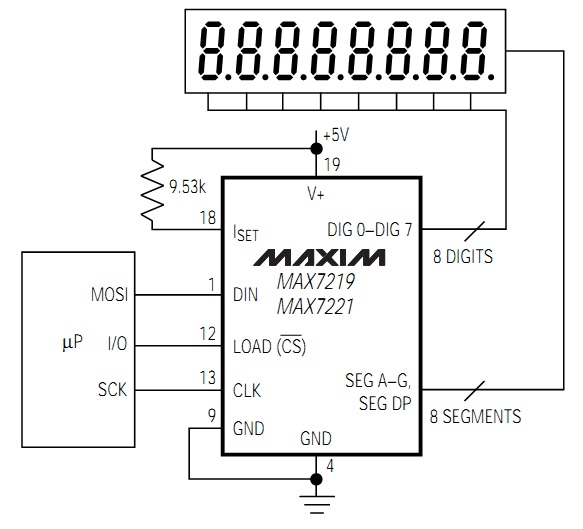
The display module is powered with +5V supply applied to its Vcc pin. Data can be transferred to the display module through SPI interface. Connections are available on the board to access the required signal lines (MOSI, CLK, and CS) for communication between the SPI Master (microcontroller) and the MAX7219 chip. Data is sent in 16-bit packets (two bytes) which is shifted into the internal 16-bit shift register with each rising edge of CLK. The 16-bit packet is labeled as D0-D15, where D0-D7 contain the data, D8-D11 contain the register address, and D12-D15 are don’t care bits. D15 is the most significant bit (MSB) and is the first bit to receive. Although the MAX7219 chip can drive up to 8 digits, only 4 digits are implemented here. They are DIG0 through DIG3, arranged in sequence from the right to the left. The 4-bit addresses (D8-D11) of their corresponding digit registers are 0×01, 0×02, 0×03, and 0×04, respectively. The digit registers are realized with an on-chip 8×8 SRAM, and are addressed directly so that individual digits can be updated at any time. The following table lists the complete addressable digit and control registers of the MAX7219 device.
Register address map of MAX7219
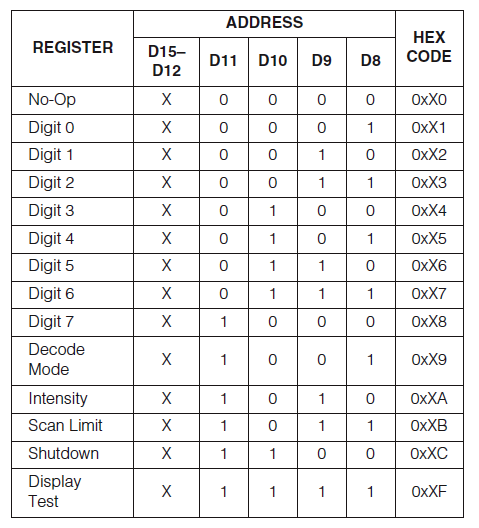
Control Registers
The MAX7219 contains 5 control registers: decode mode, display intensity, scan limit (number of scanned digits), shutdown, and display test (all LEDs on).
Shutdown
On initial power-up, all control registers are reset, and the MAX7219/MAX7221 enters into Shutdown mode. In the shutdown mode, the display is blanked. The D0 bit of the Shutdown register (address 0x0C) must be set to bring the display to normal operation. The same bit can be cleared anytime during operation to enter back into the Shutdown mode. During Shutdown, the contents of the data and control registers are unaltered. Shutdown can be used to save power or as an alarm to flash the display by successively entering and leaving the Shutdown mode.
The MAX7219 device can be put in the Shutdown mode by sending two bytes 0x0C (address) and 0×00 (data) in sequence. Similarly, 0x0C followed by 0×01 brings it back to normal operation.
Decode-Mode
The decode-mode register (address 0×09) sets BCD code B (0-9, E, H, L, P, and -) or no-decode operation for each digit. Each bit in the register corresponds to one digit. A logic high selects code B decoding while logic low bypasses the decoder. When the code B decode mode is used, the decoder looks only at the lower nibble of the data in the digit registers (D3–D0), disregarding bits D4–D6. The D7 bit is independent of the decoder and turns the decimal point on if it is set (D7=1). For example, sending bytes 0×02 and 0×05 in sequence sets the DIG1 (second digit from the right) to display decimal 5. Similarly, 0×01 followed by 0×89 displays decimal 9 at DIG0 with its decimal point set. The following table provides the complete list of the code B font.
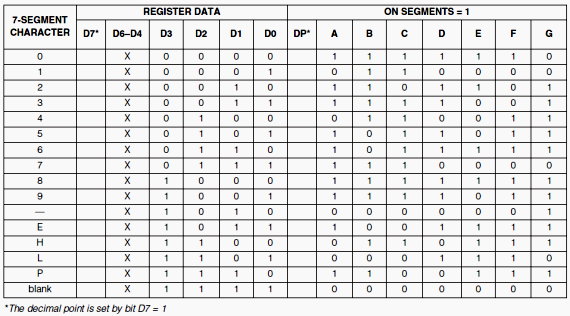
When no-decode is selected, data bits D7–D0 correspond to the segment lines (A-G and DP) of the seven segment display.
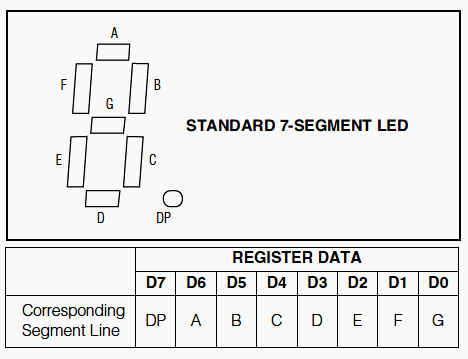
No-Decode Mode Data Bits and Corresponding Segment Lines
Intensity control
The MAX7219 allows display brightness to be controlled through software by an internal pulse-width modulator (PWM). The PWM output is controlled by the lower nibble (D3-D0) of the intensity register (address 0x0A) and allows 16 brightness levels. The zero nibble value sets the display intensity to minimum, whereas all nibble bits set to 1 selects the maximum intensity level for the display.
Scan-Limit
The scan-limit register (address 0x0B) sets how many digits are to be displayed from 1 to 8. For a 4-digit display, the scan-limit register value should be set to 0×03.
Display-Test
The display-test register has address 0x0F and allows to turn all LEDs on by overriding, but not altering, the values of the control and digit registers. In order to enable the display-test mode, the D0 bit of the display-test register must be set. The same bit must be cleared to get back to the normal operation.
Interfacing with a microcontroller
The serial 7-segment LED display module can be interfaced with any microcontroller that has 3 I/O pins available. If the microcontroller features a built-in hardware SPI, then the display module can be interfaced as a SPI slave device. In that case the SPI signal lines SDO (serial data out), SCLK (serial clock), and SS (slave select) from the microcontroller can be directly connected to the MOSI, CLK, and CS pins labeled on the display module. CS is active low signal.
In case the host microcontroller doesn’t have a hardware SPI module, the interface can be implemented in software. The SPI communication starts with holding CS pin LOW and then sending 16 bits of data serially (MSB first) over the MOSI pin at the rising edge of CLK signal, and finally pulling the CS pin back to HIGH. The following example illustrates how to write a software SPI routine to drive the display module with three general purpose I/O pins of the PIC12F683 microcontroller. The program is written in mikroC Pro for PIC compiler (mikroElektronika) but can be easily modified for other high-level compilers. The GP0, GP1, and GP2 pins of the PIC12F683 drives the CS, MOSI, and CLK pins, respectively, of the 7-segment display module to create a 4-digit up-counter. The counter counts from 0000 to 9999 and then reset to zero and start again.
The PIC12F683 microcontroller runs at 4.0 MHz internal clock and MCLR is disabled. In the picture below, the tiny PIC12F683 board is from iCircuit Technologies.
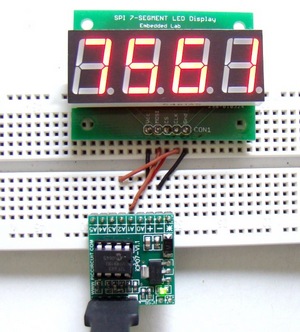
The LED display module can also be interfaced with Arduino board using the LedControl library.
Summary
This MAX7219 based LED display module allows you to interface a 4-digit 7-segment LED display to low-pin count microcontrollers using only three I/O pins. It gives you full control of all digits, decimal points, and the display brightness.
Downloads
Source Code and HEX-file - download
